Complete Solutions to Example of chapter Unit test - Properties of bulk matter of Class 11 book with complete answers and questions
| Class 11 | PHYSICS |
| Chapter | Unit test - Properties of bulk matter |
| MODERN PUBLICATION | Example |
| Number Of Questions | 100 |
| Academic Year | 2023-24 |
A steel wire of length 4.7 m and cross-sectional area `3.0 xx 10^-5 m^2` stretches by the same amount as a copper wire of length 3.5 m and cross-sectional area of `4.0 xx 10^-5 M^2` under a given load. What is the ratio of the Young’s modulus of steel to that of copper?
View SolutionFigure 9.11 shows the strain-stress curve for a given material. What are Young’sb modulus :
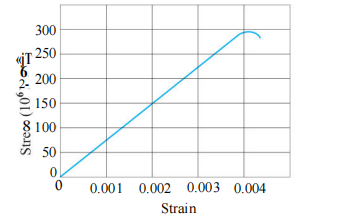
View SolutionFig. shows the stress-strain curve for a given material. What are approximate yield strength for this material ?
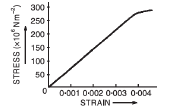
View SolutionThe stress-strain graphs for materials A and B are shown in Fig. 9.12.Tire graphs are drawn to the same scale. Which of the materials has the greater Young’s modulus:
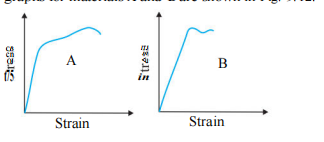
View SolutionThe stress-strain graphs for materials A and B are shown in Fig. 9.12.Tire graphs are drawn to the same scale ) Which of the two is the stronger material?
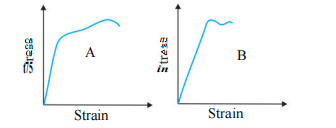
View SolutionRead the following two statements below carefully and state, with reasons, if it is true or false. The Young’s modulus of rubber is greater than that of steel,
View SolutionRead the following two statements below carefully and state, with reasons, if it is true or false. The stretching of a coil is determined by its shear modulus.
View SolutionTwo wires of diameter 0.25 cm, one made of steel and the other made of brass are loaded as shown in Fig. 9.13. The unloaded length of steel wire is 1.5 m and that of brass wire is 1.0 m. Compute the elongations of the steel and the brass wires:
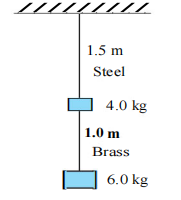
View SolutionThe edge of an aluminium cube is 10 cm long. One face of the cube isfirmly fixed to a vertical wall. A mass of 100 kg is then attached to the opposite face of the cube. The shear modulus of aluminium is 25 GPa. What is the vertical deflection of this face?
View SolutionFour identical hollow cylindrical columns of mild steel support a big structure of mass 50,000 kg. The inner and outer radii of each column are 30 and 60 cm respectively. Assuming the load distribution to be uniform, calculate the compressional strain of each column.
View SolutionA piece of copper having a rectangular cross-section of `15.2 mm xx 19.1 mm` is pulled in tension with 44,500 N force, producing only elastic deformation. Calculate the resulting strain?
View SolutionA steel cable with a radius of 1.5 cm supports a chairlift at a ski area. If the maximum stress is not to exceed `10^8 N m ^-2`, what is the maximum load the cable can support ?
View SolutionA rigid bar of mass 15 kg is supported symmetrically by three wires each 2.0 m long. Those at each end are of copper and the middle one is of iron. Determine the ratios of their diameters if each is to have the same tension.
View SolutionA 14.5 kg mass, fastened to the end of a steel wire of unstretched length 1.0 m, is whirled in a vertical circle with an angular velocity of 2 `rev//s` at the bottom of the circle. The cross-sectional area of the wire is 0.065 `cm^2`. Calculate the elongation of the wire when the mass is at the lowest point of its path.
View SolutionCompute the bulk modulus of water from the following data: Initial volume = 100.0 litre, Pressure increase = 100.0 atm (1 atm = `1.013 xx 10^5` Pa). Final volume = 100.5 litre. Compare the bulk modulus of water with that of air (at constant temperature). Explain in simple terms why the ratio is so large.
View SolutionWhat is the density of water at a depth where pressure is 80.0 atm, given that its density at the surface is `1.03 xx 103 kg m^-3`?
View SolutionCompute the fractional change in volume of a glassslab, when subjected to a hydraulic pressure of 10 atm.
View SolutionDetermine the volume contraction of a solid copper cube, 10 cm on an edge, when subjected to a hydraulic pressure of `7.0 xx 10^6` Pa.
View SolutionHow much should the pressure on a litre of water be changed to compressit by 0.10%?
View SolutionAnvils made of single crystals of diamond, with the shape as shown in Fig. 9.14, are used to investigate behaviour of materials under very high pressures. Flat faces at the narrow end of the anvil have a diameter of 0.50 mm, and the wide ends are subjected to a compressional force of 50,000 N. What is the pressure at the tip of the anvil?:
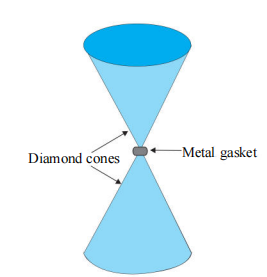
View SolutionA rod of length 1.05 m having negligible mass is supported at its ends by two wires of steel (wire A) and aluminium (wire B) of equal lengths as shown in Fig. 9.15. The cross-sectional areas of wires A and B are `1.0 mm^2 and 2.0 mm^2`, respectively. At what point along the rod should a mass m be suspended in order to produce (a) equal stresses :
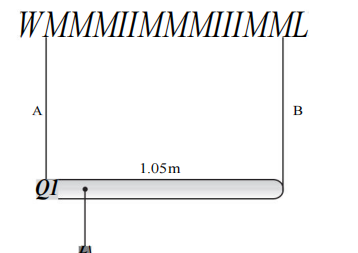
View SolutionA rod of length 1.05 m having negligible mass is supported at its ends by two wires of steel (wire A) and aluminium (wire B) of equal lengths as shown in Fig. 9.15. The cross-sectional areas of wires A and B are `1.0 mm^2 and 2.0 mm^2`, respectively. At what point along the rod should a mass m be suspended in order to produce equal strains in both steel and aluminium wires.:
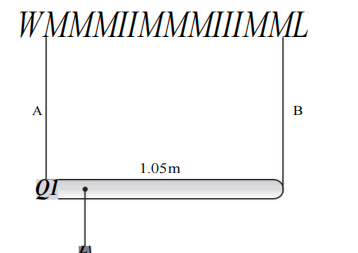
View SolutionA mild steel wire of length 2L and cross-sectional area A is stretched, well within elastic limit, horizontally between two pilars show in the figure A mass m is suspended from the mid point of the wire. Strain in the wire is .

View SolutionTwo strips of metal are riveted together at their ends by four rivets, each of diameter 6.0 mm. What is the maximum tension that can be exerted by the riveted strip if the shearing stress on the rivet is not to exceed `6.9 xx 10^7` Pa? Assume that each rivet is to carry one quarter of the load.
View SolutionThe Marina trench is located in the Pacific Ocean, and at one place it is nearly eleven km beneath the surface of water. Hie water pressure at the bottom of the trench is about `1.1 xx 10^8` Pa. A steel ball of initial volume `0.32 m^3` is dropped into the ocean and falls to the bottom of the trench. What is the change in the volume of the ball when it reaches to the bottom?
View SolutionExplain why The blood pressure in humans is greater at the feet than at the brain?
View SolutionExplain why Atmospheric pressure at a height of about 6 km decreases to nearly half of its value at the sea level, though the height of the atmosphere is more than 100 km
View SolutionExplain why Hydrostatic pressure is a scalar quantity even though pressure is force divided by area.
View SolutionExplain why The angle of contact of mercury with glass is obtuse, while that of water with glass is acute.
View SolutionExplain why Water on a clean glass surface tends to spread out while mercury on the same surface tends to form drops. (Put differently, water wets glass while mercury does not.)
View SolutionExplain why Surface tension of a liquid is independent of the area of the surface
View SolutionExplain why Water with detergent disolved in it should have small angles of contact.
View SolutionExplain why A drop of liquid under no external forces is always spherical in shape.
View SolutionFill in the blanks using the word(s) from the list appended with each statement: Surface tension of liquids generally . . . with temperatures (`increases // decreases`)
View SolutionFill in the blanks using the word(s) from the list appended with each statement: Viscosity of gases . . . With temperature, whereas viscosity of liquids . . . With temperature (`increases // decreases`)
View SolutionFill in the blanks using the word(s) from the list appended with each statement: For solids with elastic modulus of rigidity, the shearing force is proportional to ... , while for fluids it is proportional to . . . (`shear strain // rate of shear strain`)
View SolutionFill in the blanks using the word(s) from the list appended with each statement: For a fluid in a steady flow, the increase in flow speed at a constriction foliows (`conservation of mass // Bernoulli’s principle`)
View SolutionFill in the blanks using the word(s) from the list appended with each statement:For the model of a plane in a wind tunnel, turbulence occurs at a ... speed for turbulence for an actual plane (`greater // smaller`)
View SolutionExplain why To keep a piece of paper horizontal, you should blow over, not under, it
View SolutionExplain why When we try to close a water tap with our fingers, fast jets of water gush through the openings between our fingers
View SolutionExplain why The size of the needle of a syringe controls flow rate better than the thumb pressure exerted by a doctor while administering an injection
View SolutionExplain why A fluid flowing out of a small hole in a vessel results in a backward thrust on the vessel
View SolutionExplain why A spinning cricket ball in air does not follow a parabolic trajectory
View SolutionA 50 kg girl wearing high heel shoes balances on a single heel. The heel is circular with a diameter 1.0 cm. What is the pressure exerted by the heel on the horizontal floor ?
View SolutionToricelli’s barometer used mercury. Pascal duplicated it using French wine of density `984 kg m^-3`. Determine the height of the wine column for normal atmospheric pressure.
View SolutionA vertical off-shore structure is built to withstand a maximum stress of `10^9` Pa. Is the structure suitable for putting up on top of an oil well in the ocean ? Take the depth of the ocean to be roughly 3 km, and ignore ocean currents.
View SolutionA hydraulic automobile lift is designed to lift cars with a maximum mass of 3000 kg. The area of cross-section of the piston carrying the load is `425 cm^2`. What maximum pressure would the smaller piston have to bear ?
View SolutionA U-tube contains water and methylated spirit separated by mercury. The mercury columns in the two arms are in level with 10.0 cm of water in one arm and 12.5 cm of spirit in the other. What is the specific gravity of spirit ?
View SolutionA U-tube contains water and methylated spirit separated by mercury. The mercury columns in the two arms are in level with 10.0 cm of water in one arm and 12.5 cm of spirit in the other. What is the specific gravity of spirit ?
View SolutionCan Bernoulli’s equation be used to describe the flow of water through a rapid in a river? Explain.
View SolutionDoesit matter if one uses gauge instead of absolute pressuresin applying Bernoulli's equation ? Explain
View SolutionGlycerine flows steadily through a horizontal tube of length 1.5 m and radius 1.0 cm. If the amount of glycerine collected per second at one end is `4.0xx 10^-3 kg s^-1`, what is the pressure difference between the two ends of the tube ? (Density of glycerine = `1.3xx 10^3 kg m^-3` and viscosity of glycerine = 0.83 Pa s). [You may also like to check if the assumption of laminar flow in the tube is correct].
View SolutionIn a test experiment on a model aeroplane in a wind tunnel, the flow speeds on the upper and lower surfaces of the wing are `70 m s^-1`and `63 m s^-1` respectively. What is the lift on the wing if its area is `2.5 m^2` ? Take the density of air to be `1.3 kg m^-3`
View SolutionFigures refer to the steady flow of a non-viscous liquid. Which of the two figures is incorrect? Why?
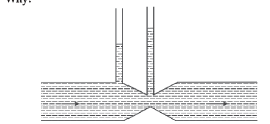
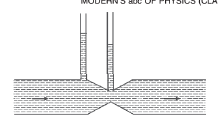
View SolutionThe cylindrical tube of a spray pump has a cross-section of `8.0 cm^2` one end of which has 40 fine holes each of diameter 1.0 mm. If the liquid flow inside the tube is `1.5 m min^-1`, what is the speed of ejection of the liquid through the holes ?
View SolutionA U-shaped wire is dipped in a soap solution, and removed. The thin soap film formed between the wire and the light slider supports a weight of `1.5xx 10^-2 N` (which includes the small weight of the slider). The length of the slider is 30 cm. What is the surface tension of the film ?
View SolutionFigure 10.24 (a) shows a thin liquid film supporting a small weight = `4.5xx 10^-2` N. What is the weight supported by a film of the same liquid at the same temperature in Fig. (b) and (c) ? Explain your answer physically:
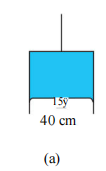
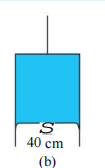
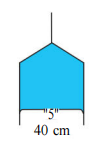
View SolutionWhat is the pressure inside the drop of mercury of radius 3.00 mm at room temperature ? Surface tension of mercury at that temperature (`20^@C`) is `4.65xx10^-1 N m^-1`The atmospheric pressure is `1.01xx 10^5Pa`. Also give the excess pressure inside the drop.
View SolutionWhat is the excess pressure inside a bubble of soap solution of radius 5.00 mm,given that the surface tension of soap solution at the temperature (20^@C) is 2.50xx 10 2 N in 1 ? If an air bubble of the same dimension were formed at depth of 40.0 cm inside a container containing the soap solution (of relative density 1.20), what would be the pressure inside the bubble ? (1 atmospheric pressure is 1.01xx 105 Pa).
View SolutionA tank with a square base of area 1.0 `m^2` is divided by a vertical partition in the middle. The bottom of the partition has a small-hinged door of area `20 cm^2`. The tank is filled with water in one compartment, and an acid (of relative density 1.7) in the other, both to a height of 4.0 m. compute the force necessary to keep the door close.
View SolutionA manometer reads the pressure of a gasin an enclosure asshown in Fig. 10.25 (a) When a pump removes some of the gas, the manometer reads as in Fig. 10.25 (b) The liquid used in the manometersis mercury and the atmospheric pressure is 76 cm of mercury.Give the absolute and gauge pressure of the gas in the enclosure for cases (a) and (b), in units of cm of mercury.:
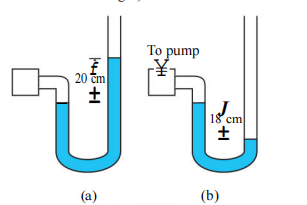
View SolutionA manometer reads the pressure of a gasin an enclosure asshown in Fig. 10.25 (a) When a pump removes some of the gas, the manometer reads as in Fig. 10.25 (b) The liquid used in the manometersis mercury and the atmospheric pressure is 76 cm of mercury.How would the levels change in case (b) if 13.6 cm of water (immiscible with mercury) are poured into the right limb of the manometer ? (Ignore the small change in the volume of the gas).:
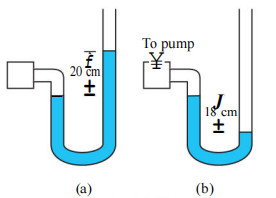
View SolutionTwo vessels have the same base area but different shapes. the first vessel takes twice the volume of water than the second, vessel requires to fill upto a particular common height. Is the force exerted by water on the base of the vessel the same in the two cases? If so, why do the vessel filled with water to that same height give differnt readings on a weighing scale?
View SolutionTwo vessels have the same base area but different shapes. the first vessel takes twice the volume of water than the second, vessel requires to fill upto a particular common height. Is the force exerted by water on the base of the vessel the same in the two cases? If so, why do the vessel filled with water to that same height give differnt readings on a weighing scale?
View SolutionDuring blood transfusion the needle isinserted in a vein where the gauge pressure is 2000 Pa. At what height must the blood container be placed so that blood may just enter the vein ? [Use the density of whole blood from Table 10.1],
View SolutionIn deriving Bernoulli's equation, we equated the work done on the fluid in the tube to its change in the potential and kinetic energy. Do the dissipative forces become more important asthe fluid velocity increases ? Discuss qualitatively.
View SolutionIn deriving Bernoulli's equation, we equated the work done on the fluid in the tube to its change in the potential and kinetic energy. Do the dissipative forces become more important asthe fluid velocity increases ? Discuss qualitatively.
View Solution(a) What is the largest average velocity of blood flow in an artery of radius `2 xx 10^-3` m if the flow must remain laminar? (b) What is the corresponding flow rate? (Taking viscosity of blood to be `2.084 xx 10^-3 Pa s)`
View Solution(a) What is the largest average velocity of blood flow in an artery of radius `2 xx 10^-3` m if the flow must remain laminar? (b) What is the corresponding flow rate? (Taking viscosity of blood to be `2.084 xx 10^-3 Pa s)`
View SolutionA plane is in level flight at constant speed and each of its two wings has an area of `25 m^2`. If the speed of the air is `180 km//h` over the lower wing and `234 km//h` over the upper wing surface, determine the plane’s mass. (Take air density to be `1 kg m^-3`)
View SolutionIn Millikan’s oil drop experiment, what is the terminal speed of an uncharged drop of radius `2.0xx 10^5` m and density `1.2xx 10^3 kg m^-3`. Take the viscosity of air at the temperature of the experiment to be `1.8xx 1 0^-5` Pa s. How much is the viscous force on the drop at that speed ? Neglect buoyancy of the drop due to air
View SolutionMercury has an angle of contact equal to `140^@` with soda lime glass. A narrow tube of radius 1.00 mm made of this glass is dipped in a trough containing mercury. By what amount does the mercury dip down in the tube relative to the liquid surface outside ? Surface tension of mercury at the temperature of the experiment is 0.465 `N m^-1`. Density of mercury = `13.6xx 10^3 kg m^-3`.
View SolutionTwo narrow bores of diameters 3.0 mm and 6.0 mm are joined together to form a U-tube open at both ends. If the U-tube contains water, what is the difference in its levels in the two limbs of the tube ? Surface tension of water at the temperature of the experiment is `7.3xx 10^-2 N m^-1 '. Take the angle of contact to be zero and density of water to be `1.0xx 10^3 kg m^- 3` (`g = 9.8 m s^-2`) .
View SolutionIt is known that density `rho` of air decreases with height y (in metres) as :
`rho = rho_(0) e^(-y//y_0)` where `rho_0 = 1.25 kg m^-3` is the density at sea level and `y_0` is a constant. This density variation is called the law of atmospheres. Obtain this law assuming the temperature of atomoshpere remains constant (isothermal conditions). Also assume that the value of g remains constant.
View SolutionA large ballon of volume `1425 m^3` is used to lift a payload of 400 kg. Assuming that the ballon maintains constant radius as it rises. How high does it rise? `(Take Y_0 = 8000 m` and `rho_(He) = 0.18 kg m^-3)`
View SolutionThe triple points of neon and carbon dioxide are `24.57 k` and `216.55 K` respectivley. Express these temperatures on the Celsius and Fahrenheit scales.
View SolutionTwo absolute scals A and B have triple points of water defined to be 200 A and 350 B. What is the relation between `T_A` and `T_B`?
View SolutionThe electrical resistance in ohms of any specimen of material varies with temperature according to the approximate law.
`R - R_0 [1 + 5 xx 10^-3 (T - T_0)]` The resistance is `101.6 Omega` at triple point of water and 165.5 at normal meting point of head (600.5K). What is the temperature when the resistance is `123.4 Omega`?
View SolutionWhat is wrong in taking the melting point of ice and the boiling point of water as standard fixed point?( as was originally done in Celsius scale)
View SolutionAnswer the following
There were two fixed points in the original celsius scale as mentioned above which were assigned the number `0^@C` and `100^@C` respectively. On the absolute scale, one of the fixed points is the triple point of water which on the kelvin absolute scale is assigned the number 273.16 K. What is the other fixed point on this (kelvin ) scale?
View SolutionAnswer the following
The absolute temperature (kelvin scale) T is related to the temperature `T_C` on the celsius scale by `T_C = T - 273.15`. Why do we have 273.15 in this relation and not 273.16?
View SolutionAnswer the following
What is the temperature of the triple point of water on an absolute scalw whose unit interval size is equal to that of the Fahrenheit scale?
View SolutionTwo ideal gas thermometers A and B use oxygen and hydrogen respectively. The following observation are made: What further procedure is needed in the experiment to reduce the discrepancy between the two readings?

View SolutionA steel tape 1 metre long is correctly calibrated for temperature of `27.0^@C`. The length of a steel rod measured by this tape is found to be 63.0 cm on a h ot day when the temperature is `45^@C`. What is the actual length of the steel rod on that day? What is the length of the same steel rod on a day when the temperature is `27.0^@C`? Coefficient of linear expansion of steel `= 1.20 xx 10^-5 C^-1`.
View SolutionA large steel wheel is to be fitted on a shaft of the same material . At `27^@C`, the outer diameter of the shaft is 8.70 cm and the diameter of the central hole in the wheel is 8.69 cm. The shaft is cooled using 'dry ice'. At what temperature of the shaft does the wheel slip on the shaft? Assume coefficient of linear expansion of the steel is to be constant over the required temperature range : `alpha_(steel) = 1.20 xx 10^-5 K`.
View SolutionA hole is drilled in a copper sheet. The diameter of the hole is 4.24 cm at `27^@C`. What is the change in the diameter of the hole when the sheet is heated to `227^@C`? Coefficient of linear expansion of copper ` = 1.70 xx 10^5 ^@C^-1`.
View SolutionA brass wire 1.8 m long at `27^@C` is held when taut with little tension between two rigid supports. If the wire is cooled to a temperature - `39^@C`, what is the tension developed in the wire, if tis diameter is 2.0 mm? Coefficient of linar expansion of brass ` = 2.0 xx 10^5 ^@C^-1`, Young's modulus of brass ` = 0.91 xx 10^11 Pa`.
View SolutionA brass rod of length 50 cm and diameter 3.00 mm is joined to a steel rod of the same length and diameter. What is the change in length of the combined rod at `250^@C`, if the original lengths are at `40.0^@C`? Is there a 'thermal stress' developed at the junction? The ends of the rod are free to expand coefficent of linear expansion of brass ` = 2.0 xx 10^-5 ^@C^-1`, steel ` = 1.2 xx 10^-5 ^@C^-1`).
View SolutionThe coefficient of volume expansion of glycerine is `49 xx 10^-5 ^@C^-1`. What is the fractional change in its density for `30^@C` rise in temperature?
View SolutionA 10 kW drilling machine is used to drill a bore in a small aluminium block of mass 8.0 kg. How much is the rise in temperature of the block in 2.5 minutes, assuming 50% of power is used up in heating the machine itself or lost to the surroundings. Specific heat of aluminium ` = 0.91 J g^-1 ^@C^-1`
View SolutionA coper block of mass 2.5 kg is heated in a furnace to a temperature of `500 ^@C` and then placed on a large ice block. What is the maximum amount of ice that can melt? (specific heat of copper ` = 0.39 J g^-1 C^-1`, heat of fusion of watter =`335 J g^-1`).
View SolutionIn a experiment on the specific heat of a metal, a 0.20 kg block of the metal at `150^@C` is dropped in a copper calorimeter (of water equivalent 0.025 kg) containing 150 cc of water at `27^@C`. The final temperature is `40^@C`. Compute the specific heat of the metal. If heat losses to the surroundings are not negligible, is your answer greater or smaller than the actual value for specific heat of the metal?
View SolutionGiven below are observations on molar specific heats at room temperature of some common gases The measured molar specific heats of these gases are markedly different from those for monatomic gases. Typically, molar specific heat of a monatomic gas is `2.92 cal/mol K`. Explain this difference. What can you infer from the somewhat larger (than the rest) value for chlorine ?
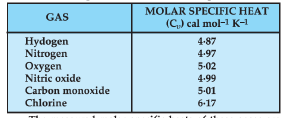
View SolutionAnswer the following questions based on the P-T phase diagram of carbon dioxide:
At what temperature and pressure can the solid, liquid and vapour phases of `CO_2` co-exist in equilibrium?
View SolutionAnswer the following questions based on the P-T phase diagram of carbon dioxide:
What is the efect of decrease of pressure on the fusion and boiling point of `CO_2`?
View SolutionAnswer the following questions based on the P-T phase diagram of carbon dioxide:
What are the critical temperature and pressure for `CO_@`? What is their significance?
View SolutionAnswer the following questions based on the p-T phase diagram of carbon dioxide as shown in the figure . Is `C0_(2)` solid , liquid, or gas at (a)` -70^(@)C` under 1 atm?
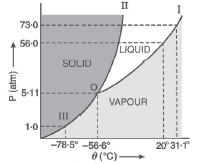
View SolutionAnswer the following questions based on the p-T phase diagram of carbon dioxide as shown in the figure . Is `C0_(2)` solid , liquid, or gas at `-60^(@)C` under 10 atm?
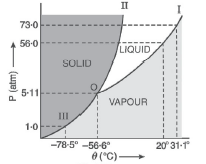
View SolutionAnswer the following questions based on the p-T phase diagram of carbon dioxide as shown in the figure . Is `C0_(2)` solid , liquid, or gas at `15^(@)C` under 56 atm ?

View SolutionAnswer the following questions based on the P-T phase diagram of `CO_2`
`CO_2` at 1 atm pressure and temperature `60^@C` is compressed isothermally. Does it go through a liquid phase?
View Solution
Example questions and complete solutions for chapter Unit test - Properties of bulk matter of MODERN PUBLICATION of Class 11